I. What are the Fundamentals and Patterns of Dominance in Mendelian Genetics?
As you’ve probably noticed whether taking a course in college or in the colored circles and squares on a medical family pedigree, the study of genetics is one of the most fascinating fields in biological sciences, as there are so many applications to its study.
As a field of study, we owe all thanks to Gregor Mendel, a priest and biologist (talk about a double life!) who is widely regarded and thought of as the father of genetics. From his work came the ideas of genotypes, phenotypes, codominance, etc.
In this section, you’ll probably notice that it’s not so much about memorization, but more about developing problem solving skills as well as a sound flow of logic, as skills like these will be of great use when you take the exam.
II. Content Review
At its most basic form, genetics can be thought of as the relationship on how genes result in the physical characteristics of organisms. There are 2 main terms to become familiar with:
⇒ Genotype:
This term can either describe the genetic composition of an organism or the allelic combination of a gene.
We encourage you all to use the second definition as it's a bit more specific; likewise, the first definition is a bit more general.
⇒ Phenotype:
This term describes the observable physical characteristics of an organism, which result from the genotype! You might think of characteristics as something “exterior” such as hair or eye color, but they also refer to characteristics on the cellular level.
For example, these characteristics include the production of a metabolic enzyme or the hyper synthesis and hypersecretion of potassium ions into the bloodstream!
As pointed out above, the phenotype is dependent on the genotype! Look to the diagram below to get a better visual understanding of this relationship!
>> Patterns of Dominance
Though it says dominance, it may be helpful to think of this rather as patterns of expression, as this topic is more about different expression patterns of genotypes and phenotypes.
Before understanding these patterns, let’s quickly review homologous chromosomes and their contribution in genetics. Recall that because our chromosome pairs are homologous, we have 2 copies of each gene.
Likewise, genes can have multiple allelic variants which allows for various allelic combinations to be made. However, now with this added layer of complexity, the observed phenotype will depend on the expression pattern of the genotype!
⇒ Complete Dominance
This is the simplest expression pattern and requires you to be familiar with the following 2 terms:
- Dominant: Only 1 allele copy needs to be present in order to express the phenotype
- Recessive: 2 allele copies need to be present in order to express the phenotype
In addition, the terms homozygous and heterozygous are also used to describe the individual’s genotype (i.e. allelic combination). Homozygous genotypes have the same allele while heterozygous genotypes have different alleles.
Take a look at the example below to get a better understanding of this expression pattern!
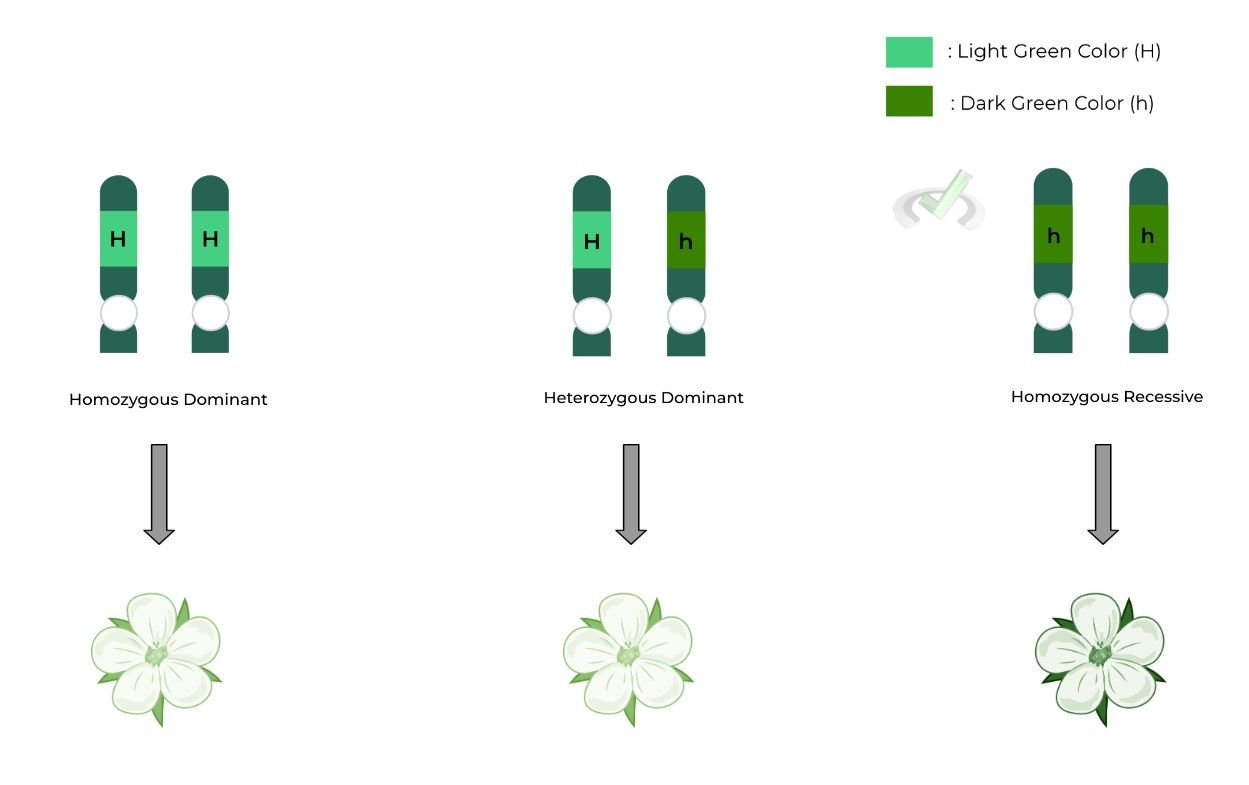
Let’s breakdown this example! The H allele codes for a light green flower color and is the DOMINANT allele because as shown in the middle (heterozygous dominant) case, only 1 H allele is needed to express the light green color. You can think of the H allele “masking” the h allele in terms of dominance.
The right (homozygous recessive) case shows why the h allele is recessive: 2 h alleles needed to be present in order to express the dark green color.
Also note the names of the cases! The 1st word describes whether the alleles are the same or different and the 2nd word describes whether the dominant or recessive trait is expressed:
I.e. Hh → Heterozygous Dominant
1st Word: Heterozygous – H and h alleles are different
2nd Word: Dominant – Dominant (light green color) is expressed
⇒ Codominance
Just like how it sounds, this type of expression pattern occurs when more than one trait can be expressed simultaneously. Another way to word or think about it is that there is more than one dominant allele.
For this expression type, it is best observed in a heterozygous genotype because 2 different alleles will be present!
Take a look at the following example!
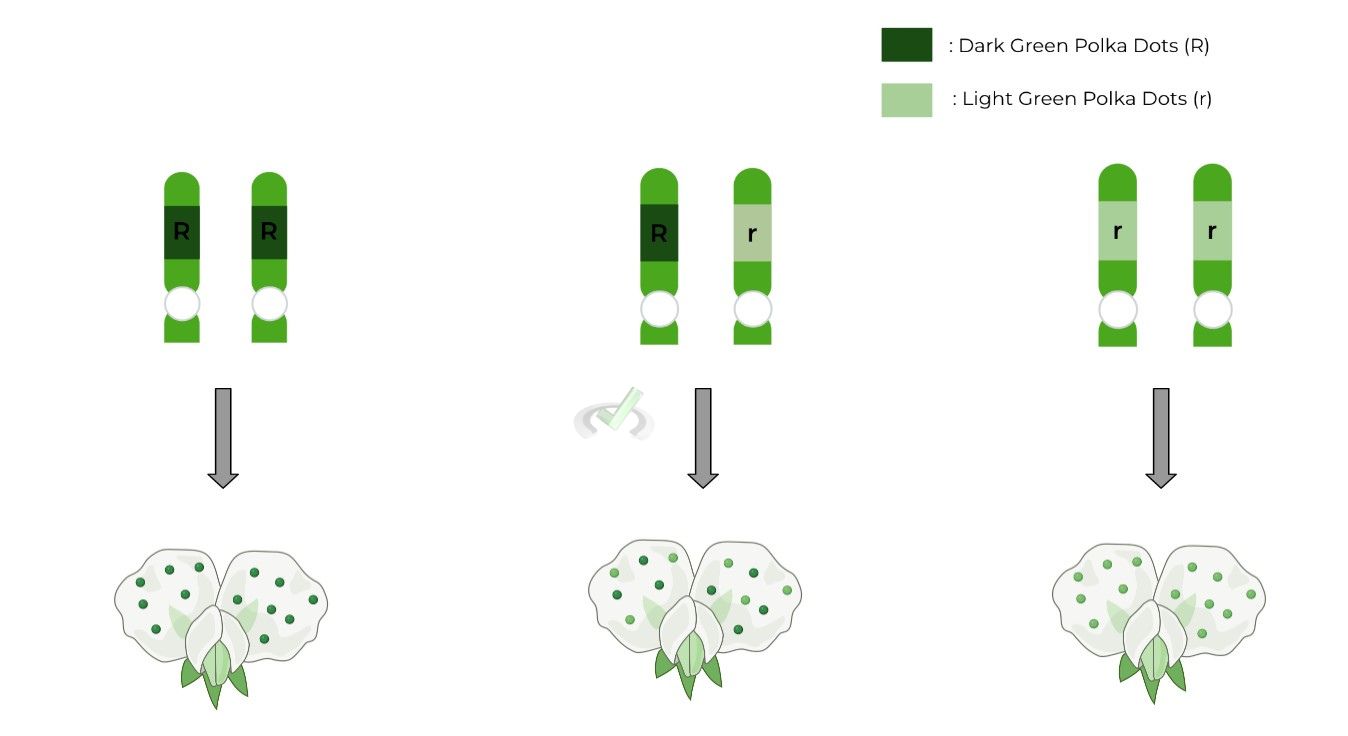
Similarly, let’s break this down, particularly the middle (heterozygous) case. The gene codes for polka dot color, with the R allele coding for a dark green polka dot and the r allele coding for a light green polka dot.
The left and right (homozygous) cases are self explanatory; however, the heterozygous case shows that both the dark and light green polka dot are expressed! This is because both alleles are present in the heterozygous genotype.
⇒ Incomplete Dominance
Finally, this type of expression pattern occurs when a heterozygous genotype results in a trait that is intermediate between those coded by the alleles.
A nice, little trick/mnemonic for this expression pattern is to think INcomplete dominance results in an INtermediate phenotype. Similar to codominance, this pattern is best for heterozygous genotypes.
Like the others, take a look at this example!
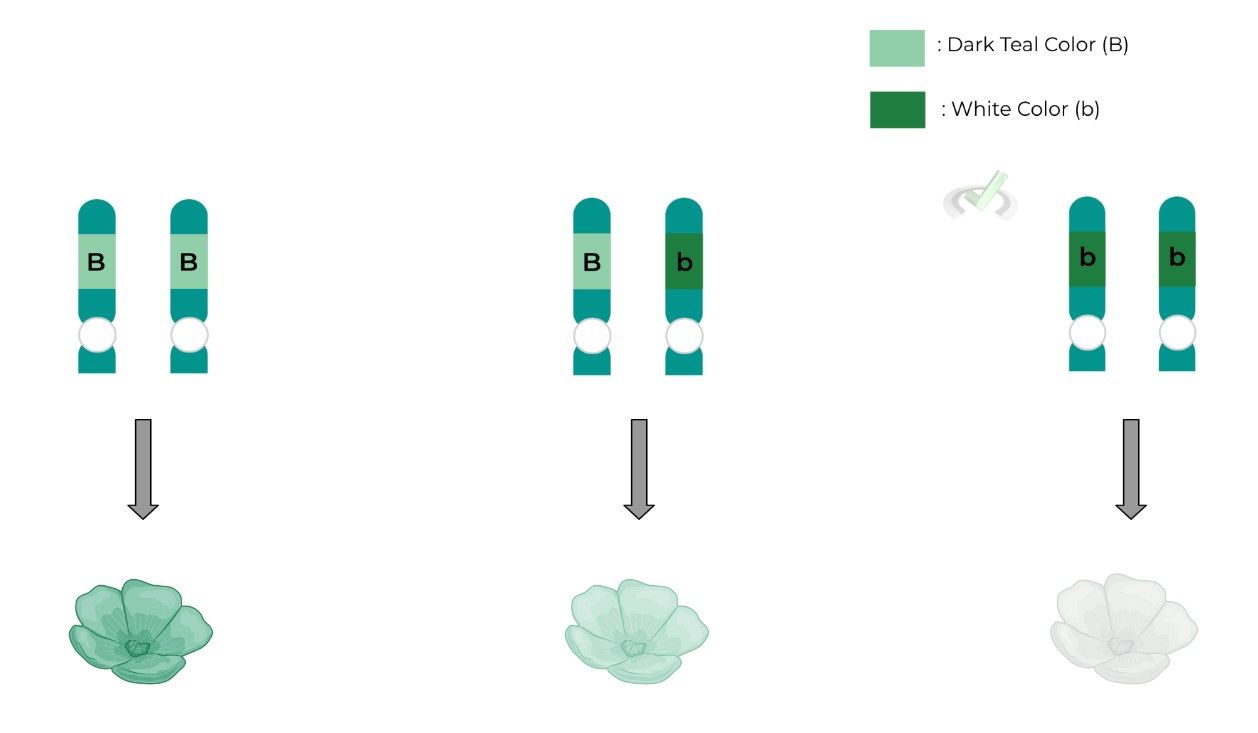
Similar to the codominance case, pay special attention to the middle (heterozygous) case! The gene codes for petal color, with the B allele coding for a dark teal color and the b allele coding for a white color.
Again, the left and right (homozygous) cases are self explanatory; however, the heterozygous case shows that an intermediate phenotype is created, with a light teal petal color being expressed, as both alleles are present in the heterozygous genotype.
You can think of the intermediate being a “mix” or the “average” of the 2 extremes, hence the term intermediate!
III. Bridge/Overlap
So far, the examples mentioned above are best understood from an individual perspective, basically meaning it’s best to view it from the viewpoint of one organism.
However, can Mendelian genetics be applied to the population level: absolutely!! From here comes the terms and concepts of penetrance and expressivity!
Pay attention to how the terms genotype and phenotype play into understanding these concepts!
>> Penetrance
This term refers to the percentage or portion of the population which expresses a phenotype given a specific genotype. Interestingly, sometimes even when a person has a genotype which codes for a phenotype, that phenotype won’t be expressed.
Take a look at the example below! Say we have a complete dominance genotype GG which codes for black hair. The dark green dots below represent individuals in the population.
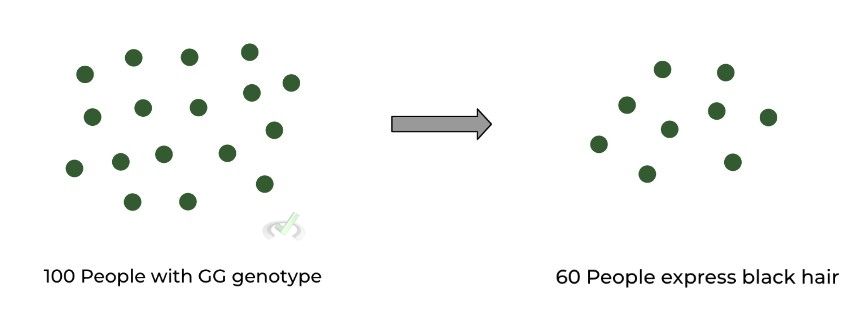
As shown in the example above, in a population of 100 people which have a GG genotype, only 60 people of that group express black hair.
A proper way to describe this scenario is that the GG genotype has reduced penetrance because less than 100% of those with the genotype express black hair.
>> Expressivity
A similar, related concept to penetrance, expressivity describes when there is a wide range/variability of phenotypes that emerges from a single genotype.
One great real world example of expressivity is Marfan Syndrome, which results from a dominant mutation in the FB1 gene. However, affected individuals have this mutation from mild skeletal system signs to major cardiovascular problems.
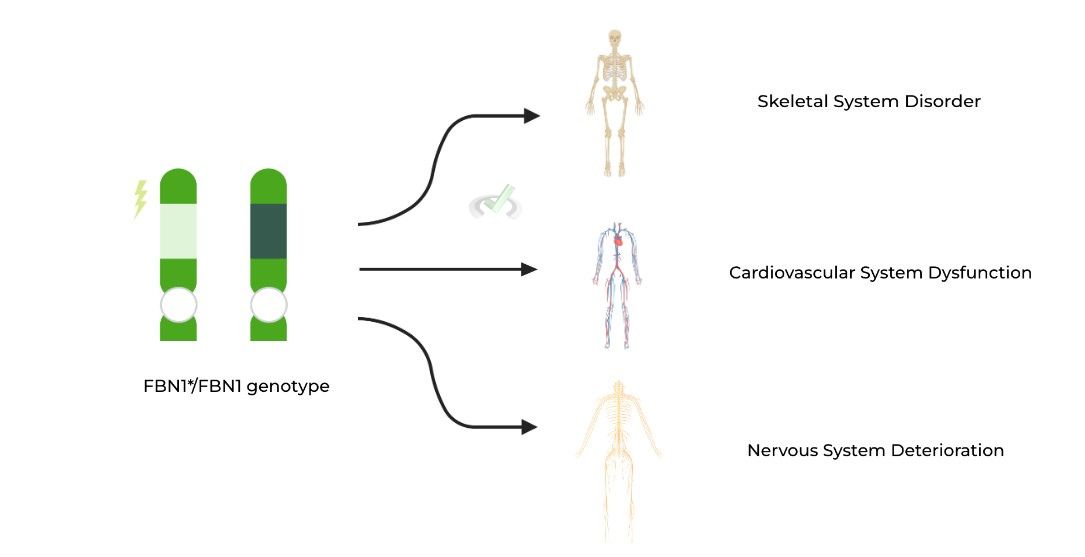
IV. Wrap Up/Key Terms
Let’s take this time to wrap up & concisely summarize what we covered above in the article!
Here’s a table of some important terms to be familiar with from the article!
Term | Definition |
|---|---|
Genotype | Can refer to the genetic constitution of an organism or an individual’s allelic combination |
Phenotype | Observable physical characteristics that is coded by the genotype |
Dominant | Describes a phenotype which only requires 1 allele in order to be expressed |
Recessive | Describes a phenotype which requires alleles in order to be expressed |
Homozygous | Refers to when the 2 alleles for a gene are the same |
Heterozygous | Refers to when the 2 alleles for a gene are different |
>> Patterns of Dominance
The three main dominance or expression patterns are: 1) complete dominance, 2) codominance, and 3) incomplete dominance.
⇒ Complete Dominance
In complete dominance, a dominant allele can “mask” the recessive allele as only 1 dominant allele is needed to express that phenotype. There are 3 possible cases shown below using A as the dominant allele and a as the recessive allele:
Homozygous Dominant: AA → “A” Phenotype Expressed
Heterozygous Dominant: Aa → “A” Phenotype Expressed
Homozygous Recessive: aa → “a” Phenotype Expressed
⇒ Codominance
This occurs when there are more than 1 dominant allele! In other words, 2 or more phenotypes of a gene can be expressed simultaneously!
This is best exemplified through a heterozygous genotype because there will be 2 different alleles in the allelic combination!
⇒ Incomplete Dominance
This occurs when the heterozygous genotype results in an intermediate between the phenotypes coded by the alleles!
A good mnemonic/trick to remember this is to think an “INtermediate” phenotype occurs for “INcomplete” dominance.
>> Applications on Population Level
While the terms above are primarily concerned on an individual level, they can also be applied to a population level!
⇒ Penentrace:
Refers to the percentage or portion of the population that expresses a phenotype given a specific genotype
⇒ Expressivity:
Refers to the wide variability of phenotypes that can emerge from a single genotype.
V. Practice
Take a look at these practice questions to see and solidify your understanding!
Sample Practice Question 1:
A certain gene codes for the color of the spots on a certain species of horses. The gene has 2 alleles: the H allele coding for a black color spot and the h allele coding for a white color spot – the gene also is described as having a codominance expression pattern. Given a genotype, Hh, what should the color of the horse’s spots be?
A. Black
B. White
C. Gray
D. Black and White
Ans. D
In codominance, there can be 2 or more dominant alleles meaning that phenotypes can be expressed simultaneously! In this case, the heterozygous genotype contains both alleles, which means that both black and white colored spots will be present on the horses.
Sample Practice Question 2:
Given a gene that codes for hair color and has a complete dominance expression pattern, the R allele is dominant and codes for blonde hair while the r allele is recessive for brown hair. Which of the following genotypes below will result in a blonde phenotype?
I. RR
II. Rr
III. rr
A. I only
B. II only
C. I and III only
D. I and II only
Ans. D
In complete dominance, a dominant allele only needs one copy in order for its phenotype to be expressed while a recessive alle needs two copies in order to express its phenotype.
In this case, the homozygous dominant and the heterozygous dominant will result in the expression of the blonde hair phenotype because both these genotypes have at least one copy of the dominant allele.







 To help you achieve your goal MCAT score, we take turns hosting these
To help you achieve your goal MCAT score, we take turns hosting these 





















 reviews on TrustPilot
reviews on TrustPilot